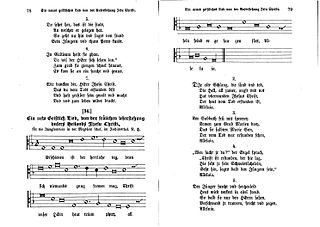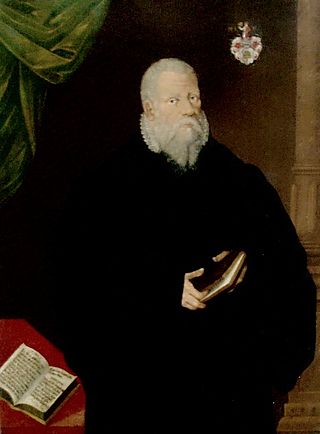Related Research Articles

Evangelisches Gesangbuch is the current hymnal of German-language congregations in Germany, Alsace and Lorraine, Austria, and Luxembourg, which was introduced from 1993 and 1996, succeeding the Evangelisches Kirchengesangbuch (EKG). Evangelisches Gesangbuch appears in 14 different regional editions, which add regional hymns to the 535 hymns common for all editions.

"Gott sei gelobet und gebenedeiet" is a Lutheran hymn of 1524 with words written by Martin Luther who used an older first stanza and melody. It is a song of thanks after communion. Luther's version in three stanzas was printed in the Erfurt Enchiridion of 1524 and in Johann Walter's choral hymnal Eyn geystlich Gesangk Buchleyn the same year. Today, the song appears in German hymnals, including both the Protestant Evangelisches Gesangbuch, and in a different version in the Catholic Gotteslob.

Neues Geistliches Lied, abbreviated NGL, is a music genre of songs in German intended for church usage, and based on contemporary lyrics and with music by contemporary composers.

"Was mein Gott will, das g'scheh allzeit" is a Lutheran hymn in German. The text from c. 1550 is attributed to Albert, Duke of Prussia. The melody, Zahn No. 7568, goes back to a tune by Claudin de Sermisy, written in 1529 for a secular French song. The hymn has belonged to core Lutheran hymnody without interruption and is part of the Protestant hymnal Evangelisches Gesangbuch as EG 364.

"Erschienen ist der herrlich Tag" is a German Easter hymn, with text and tune written by Nikolaus Herman and published in 1561. It has inspired musical settings by composers from the 17th to the 20th century. It appears in several hymnals, including the German Protestant hymnal Evangelisches Gesangbuch. Other hymns, especially Easter hymns, in both German and English, are sung to the same melody.

"Nun lasst uns Gott dem Herren" is a Lutheran hymn of 1575 with words by Ludwig Helmbold. It is a song of thanks, with the incipit: "Nun lasst uns Gott dem Herren Dank sagen und ihn ehren". The melody, Zahn No. 159, was published by Nikolaus Selnecker in 1587. The song appears in modern German hymnals, including in the Protestant Evangelisches Gesangbuch as EG 320.
"Den Herren will ich loben" is a Christian hymn by Maria Luise Thurmair, based on the Magnificat and set to a 1613 melody by Melchior Teschner, which was used for "Valet will ich dir geben". The hymn in three stanzas of eight lines was first written in 1954, and revised in 1971. It appeared in the Catholic hymnal Gotteslob in 1975, and in the current Gotteslob, but also in a German Protestant hymnal. A general song of praise, it has been set to music several times.

Otto Riethmüller was a German Lutheran minister, writer, and hymnwriter. He was the president of Protestant youth organisations from 1928, published songbooks, and was a leading member of the Confessing Church. He designed the Protestant youth organization's logo, the Cross on the Globe, which is still used today.

Johann Balthasar König was a German Baroque composer, especially of hymn melodies, having published a hymnal with 1,913 melodies. He was the church musician at Frankfurt's main Protestant church, the Katharinenkirche, and the town's Kapellmeister. He was also closely associated with Georg Philipp Telemann.

"Macht hoch die Tür" is a popular German Advent hymn, written in 17th century Ducal Prussia. The lyrics were written by Georg Weissel in 1623 for the inauguration of the Altroßgärter Kirche in Königsberg. The melody that is now associated with the text appeared first in 1704 in the hymnal by Johann Anastasius Freylinghausen.

"Gott ist gegenwärtig" is a Christian hymn in German by the Reformed writer Gerhard Tersteegen, published in 1729, based on a 1680 melody by Joachim Neander. The hymn, with the melody simplified, is part of the Protestant hymnal Evangelisches Gesangbuch as EG 165 and the 2013 Catholic hymnal Gotteslob as GL 387. Seven of its eight stanzas are part of the Mennonite hymnal as No. 1. The hymn is regarded as an expression of Christian mysticism. It was translated to English in various versions.

"Dein Lob, Herr, ruft der Himmel aus" is a German Catholic hymn. Adolf Lohmann adapted a 1659 hymn by the Jesuit astronomer Albert Curtz, who paraphrased Psalm 19. The melody appeared in Augsburg in 1669. It was No. 1 in the 1938 hymnal Kirchenlied and is part of the German Catholic hymnal Gotteslob as GL 381.

"Mit Ernst, o Menschenkinder" is an Advent hymn by Valentin Thilo. It partly paraphrases the call to penitence by John the Baptist. The text was first published in 1642 in the collection Preußische Festlieder. The different melody that later became popular dates back to 1557.
"Lob Gott getrost mit Singen" is a Lutheran hymn in German, a paraphrase of the Latin Te Deum, by the Bohemian Brethren. The hymn is part of the current Protestant hymnal. The hymn was translated into English as "Praise God, praise God with singing". The hymn tune was used for several hymns in different languages, denominations and centuries.
"O komm, du Geist der Wahrheit" is a Lutheran hymn for Pentecost in German. The text was written by Philipp Spitta, probably in 1827, and published in 1833 in the song collection Psalter und Harfe. It is a prayer to the Holy Spirit for courage to confession in a time poor in faith. The hymn which first appeared without a melody, is now usually sung to the 1529 melody of "Lob Gott getrost mit Singen". It is part of the current Protestant hymnal, and of other hymnals.
Habakuk is a German pop band from Frankfurt, formed in 1975. The group is focused on new Christian music of the genre Neues Geistliches Lied.
"Herr, gib uns Mut zum Hören" is a Christian hymn, with text and melody written in 1963 by Kurt Rommel. The song, of the genre Neues Geistliches Lied (NGL), is part of German hymnals, including Gotteslob, and of songbooks.
"Wir weihn der Erde Gaben" is a Christian offertory hymn with text by Petronia Steiner to the melody of the 1529 "Lob Gott getrost mit Singen". It appeared in the first edition of the Catholic hymnal Gotteslob and is part of its second edition. Several composers wrote settings for use in church.
"Ich lobe meinen Gott von ganzem Herzen" is a Christian hymn in German, with a first stanza by Gitta Leuschner, written in 1980, and two more stanzas that Günter Balders added in 2002. The text is based on Psalm 9. The original song came from France and was a rather close paraphrase of the psalm, to a melody composed by Claude Fraysse in 1976. The song of the genre Neues Geistliches Lied (NGL) has appeared in the German Protestant and Catholic hymnals and songbooks, especially collections for children.
Klaus-Peter Hertzsch was a German Protestant theologian, poet, author and hymn writer.
References
- 1 2 3 "Kirchenlied "Vertraut den neuen Wegen" vor 30 Jahren veröffentlicht". Evangelische Kirche in Mitteldeutschland (EKM) (in German). 25 July 2019. Retrieved 13 March 2021.
- 1 2 3 4 Steinmann, Wolf-Dieter (15 February 2015). "Vertraut den neuen Wegen" (in German). SWR . Retrieved 13 March 2021.
- 1 2 Haas, Hans-Günter (1 January 2007). "Vertraut den neuen Wegen – Liedpredigt über EG 395,1–3" (in German). Herder Verlag . Retrieved 13 March 2021.
- 1 2 "4Bibeln: Gesangbuch / Evangelisches Gesangbuch 395". Evangelisches Gesangbuch / Niedersachsen – Bremen (in German). Retrieved 13 March 2021.
- 1 2 "Vertraut den neuen Wegen". liederdatenbank.de (in German). Retrieved 13 March 2021.